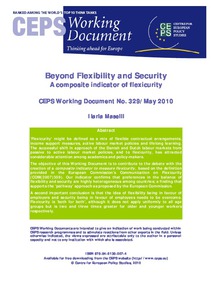Beyond flexibility and security. a composite indicator of flexicurity
"‘Flexicurity’ might be defined as a mix of flexible contractual arrangements, income support measures, active labour market policies and lifelong learning. The successful shift in approach of the Danish and Dutch labour markets from passive to active labour market policies, and to flexicurity,...
| Main Author: | |
|---|---|
| Institution: | ETUI-European Trade Union Institute |
| Format: | TEXT |
| Language: | English |
| Published: |
Brussels
2010
CEPS |
| Subjects: | |
| Online Access: | https://www.labourline.org/KENTIKA-19184913124919021959-Beyond-flexibility-and-securit.htm |
| Summary: | "‘Flexicurity’ might be defined as a mix of flexible contractual arrangements, income support measures, active labour market policies and lifelong learning. The successful shift in approach of the Danish and Dutch labour markets from passive to active labour market policies, and to flexicurity, has attracted considerable attention among academics and policy-makers.
In this Working Document, CEPS Economic Policy Research Assistant Ilaria Maselli contributes to the debate with the creation of a composite indicator to measure flexicurity, based on the definition provided in the European Commission’s Communication on Flexicurity. One finding is that preferences in the balance of flexibility and security are highly heterogeneous among countries; a finding that supports the ‘pathway’ approach as proposed by the European Commission.
A second important conclusion is that the idea of flexibility being in favour of employers and security being in favour of employees needs to be overcome. Flexicurity is ‘both for both’, although it does not apply uniformly to all age groups but is two and three times greater for older and younger workers respectively." |
|---|---|
| Physical Description: | 12 p. Digital |

